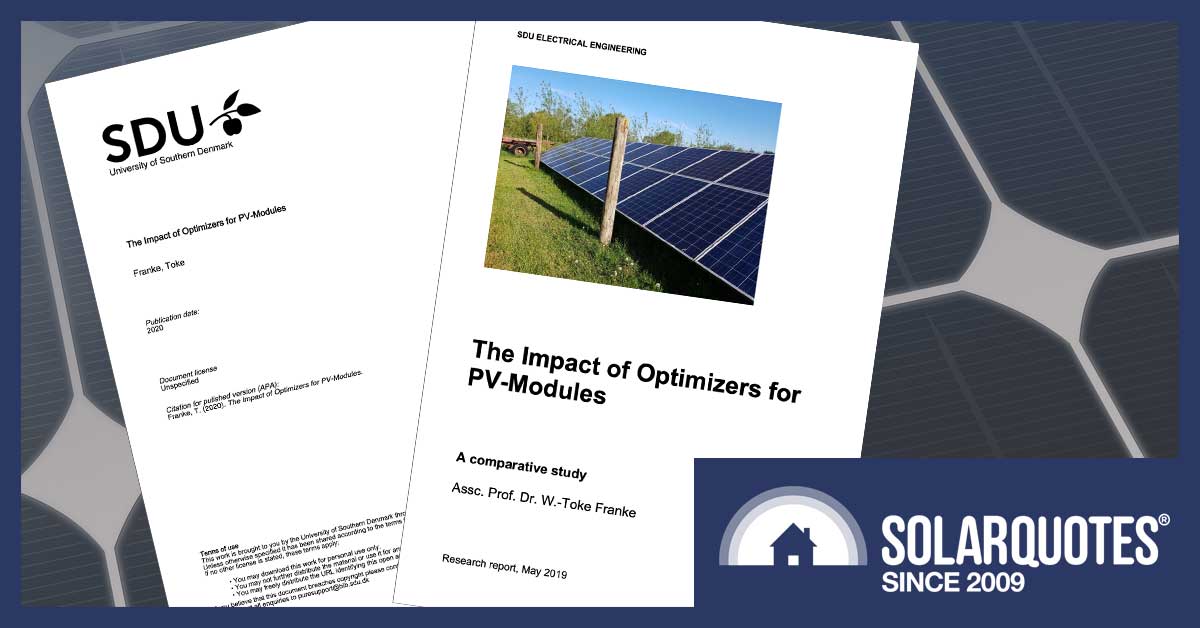
Have solar panel optimiser manufacturers been too optimistic in their performance claims? A Danish study says optimisers can be the opposite of optimal.
Solar systems hate shade. They really do. Sometimes they talk to me in my dreams and it’s always their number one complaint, right after being pooped on by birds. But these two problems are related — they hate bird poop because it shades their solar cells.
A common solution to reduce the effects of shade is to put optimisers on solar panels. These are little boxes of electronics that ensure the current provided by the panel is always optimal for maximising energy output. While this won’t do anything to make up for the reduction in light caused by shade, they can prevent one shaded panel from dragging down the performance of other panels on the same electrical cable, which is called a string.
It is possible to place optimizers only on panels that will be regularly shaded. This helps keep costs and energy losses low and allows them to be a cost effective way to reduce the effects of shade, making them a useful tool for solar system designers and installers. But I don’t recommend using them on solar panels that only suffer from minor shading or no shade at all.
In the past I would have said it is a waste of money. They aren’t cheap and these days can cost half as much as the panel they’re attached to before including the cost of installation. So I would have said you would be spending a lot of money for little or no benefit. But I may have been going a little easy on them, as a recently published Danish study says that, for an unshaded solar array, optimisers are worse than useless and will reduce overall solar output.
The study comes down pretty hard on optimisers. Its summary states:
While there were situations in which optimisers helped, the study found when a 14-panel array received shade from a single thick wooden pole, there was no overall benefit provided. This pole did not provide the heavy shading that can allow optimisers to boost output, but does suggest they are not worthwhile for reducing the effects of light to moderate shade. Another interesting result was optimisers could be less useful for countering the effects of shade from objects in countries that are sunnier than Denmark. Australia is definitely one of these.
A Danish Study
The study was called “Impact of Optimizers for PV-Modules“. It was published by SDU — the Universtity of Southern Denmark — and the author was Toke Franke. I wasn’t able to find much about him except that he’s been involved in writing enough papers to make him a PV research publishing powerhouse. I did discover his full name is Wulf-Toke Franke, which I presume is the Danish equivalent of being called Dingo-Toke Franke, so I wouldn’t mess with him.
Note his name is Toke and not Toki, so he has nothing to do with the Danish musician Toki. At least, I assume he doesn’t. For all I know, they could be brothers. It would be just like Danish parents to name one kid Toke and the other Toki and expect everyone to keep them straight.

Danish musician Toki speaking his native tongue.
3 Systems Were Tested
The study used a set of 42 solar panels located on a small European peninsula packed full of Vikings and dairy cows called Denmark:

The picture on the left is the actual test site in Denmark. The picture on the right is the test site after it has been Southern Hemisphere adjusted.
Testing was conducted over a year. Because at some times of year solar panels were shaded by Danish vegetation, after 5:22 pm testing was always stopped at this time to ensure comparable results. The 42 panels consisted of three strings of 14 fitted with the following hardware:
- A 3.6 kilowatt SMA inverter without optimisers.
- A 3.6 kilowatt SMA inverter with an optimiser manufactured by Tigo on every panel.
- A 3.6 kilowatt SolarEdge inverter. These require SolarEdge optimisers on every panel.
I’ve put a table from their report with some details below. Note that MLEP stands for Module Level Power Electronics which is what Toke Franke calls an optimiser. I’ve anointed the table in red Comic Sans to make it clear.1
SMA is a German inverter manufacturer that uses what the study refers to as “advanced MPP-tracking“. According to SMA this helps reduce the effects of shading. I would expect all decent quality inverters these days to have something similar.
Tigo make the most commonly used optimisers in Australia. While they are now are generally considered very reliable, one failed early in testing. Here’s a review of them by MC Electrical. These can be placed only on panels that suffer from heavy shading, but in this study all 14 panels received one.
SolarEdge inverters require SolarEdge optimisers on every panel and can’t be placed only on those that need them. SolarEdge optimisers have had some reliability issues reported but — as you would expect — none of the 14 used failed over the year long test period.
Microinverters & MAXIM Optimised Panels Not Tested
Two methods used to deal with the knock-on effects of shade falling on panels that were not tested were:
- Microinverters: These are itty bitty inverters that go on the back of panels and let them operate independently.
- MAXIM optimised panels: Instead of being attached to the panel, optimisation is built in.
Microinverters are a solution that prevents the knock-on effects of shade but tend to be more expensive than standard string inverters. String inverters get cheaper per watt as they increase in size but microinverters don’t, so they can significantly increase the cost of a larger system and only a small portion of Australian systems currently use them.
MAXIM optimised panels — technically at least — should work better than panels that have external optimisers bolted, screwed, or strapped to them.2 However, early versions could interfere with television reception. This problem appears to have been overcome and they are quietly being installed in Australia again. If there are no more problems I expect they’ll become popular.
3 Test Conditions
The three systems were tested under three conditions:
- Normal performance without shading.
- Performance with 1 out of 14 panels covered with a light cloth to reduce the amount of light it received. This simulated panels receiving different amounts of light due to facing different directions.
- Performance when shaded by a single 20cm thick pole.
The results were:
- No shading — Optimisers lose
- One panel covered — Optimisers win
- Shaded by pole — Inconclusive
So it could be said that under these conditions, the performance of both sets of optimized panels turned out to be completely Meatloaf. That is, two out three ain’t bad…
Clear Skies — Optimisers Lose
On a clear cloudless day — a rare thing in Denmark — it was found the system with no optimisers performed slightly better:
Because the table above has the disgusting Danish habit of using a comma instead of a decimal point…
…I’ll repeat the results below.
When the output of the unoptimised system is set at 100%, the output of the three systems over a clear day was:
- No optimisers: 100%
- Tigo optimisers: 99.6%
- SolarEdge optimisers: 99.8%
The lower output of optimised systems was because the optimisers each consumed a small amount of power while providing little or possibly no benefit.
While testing wasn’t continued past 5:22 pm it probably would have been worse for the optimised systems if it had, as they were found to have even lower relative performance under low light conditions.
Cloudy Skies — Optimisers Lose More
The graph below shows the output of the three systems on a day that started out overcast and then changed to patchy cloud towards noon:
While it’s hard to tell which did best from the graph, the performance of the optimised systems was relatively worse under these conditions.
With the no optimiser system set at 100%, their outputs were:
- No optimisers: 100%
- Tigo optimisers: 98.9%
- SolarEdge optimisers: 99.3%
The poorer relative performance was because clouds reduce the energy output of the solar panels while optimisers continue to consume it at a similar rate. Sure, they don’t gobble much individually, but with an optimiser on every panel in a system it makes a difference.
One Panel With Reduced Output — Optimisers Win!
Toke Franke wanted to simulate the effect of one panel out of the 14 of each system having a different orientation from the others. Unfortunately, removing a panel and giving and changing its position would take effort and Wulf-Toke Franke is no doubt a busy person, so one panel was instead covered with a white cloth to reduce the amount of light falling on it:
During the six week testing period for this condition, the poor Danes didn’t have a single day that was completely clear of cloud. But on a mostly cloud free day the results were:
- No optimisers: 100%
- Tigo optimisers: 102.6%
- SolarEdge optimisers: 101.4%
As I expected, the optimised systems do a little better than the unoptimized one. Unfortunately, we don’t know how much light the sheets blocked, so it’s hard to know how impressed I should be by the modest benefit provided. (I’m pretty sure the Danes don’t know either, otherwise they would have told us.)
On an almost entirely overcast day, the results were:
- No optimisers: 100%
- Tigo optimisers: 101.5%
- SolarEdge optimisers: 100.3%
Again, under lower light conditions, the relative performance of the optimised systems is worse than on a mostly clear day, but under this condition it’s still better than not having optimizers.
Because we don’t know how much of a mismatch throwing a sheet over the panels represents, there’s not a lot we can conclude from this apart from the obvious conclusion that optimisers help reduce the effects of mismatch.
Object Shading — No Winner
The final test condition involved placing a fat pole in front of panels so its shade would move across them through the day. Because this was done in Denmark, I’ll just mention they didn’t pop across to Świnoujście in a Viking longboat and convince a few Polish people to stand in front of them at sword point. They used instead used 1.2m tall and 20cm wide wooden poles:
I was surprised by the results of this test under sunny conditions, as the system without optimisers performed best:
- No optimisers: 100%
- Tigo optimisers: 98%
- SolarEdge optimisers: 98.7%
The relative performance of the optimised systems was worse in the middle of the day when the shadow was shorter but improved later in the day as the shadow lengthened.
I would have expected optimizers to show their worth under when shaded by a fat pole, but instead they were worse then useless. However, on a day where clouds are continually blocking and unblocking the sun, as shown in this graph:
Systems with optimisers come out ahead:
- No optimisers: 100%
- Tigo optimisers: 103.1%
- SolarEdge optimisers: 104.2%
Toke Franke says this is because systems with optimisers are faster at maximising output when clouds cause the light level to change. The more changes in a day, the better systems with optimisers will do.
On overcast days the where the change is light level is gradual, not having optimisers wins:
- No optimisers: 100%
- Tigo optimisers: 99.6%
- SolarEdge optimisers: 98.3%
Over the two month testing period during the Danish spring, no system clearly outperformed the other. As Australia has more sunny days than Denmark, the system without optimisers might have come out ahead if the test was performed here.
Annual Output — Tigo Optimisers Lose
Over a full year of testing the energy output of the no optimisers and SolarEdge system were basically the same, while the Tigo optimised system came last:
- No optimisers: 100%
- Tigo optimisers: 97.55%
- SolarEdge optimisers: 99.95%
But note that only part of this year involved normal, unshaded use. The rest involved either sheets or poles, so take that into account when considering how it may apply to your own roof.
If you’d like all the information in one big table, don’t worry, Toke Franke has got you covered:
Australian Conditions
In Australia, because we have much clearer skies, if the testing had been done here I would assume….
- No Shading: No-optimisers would still provide a benefit but it would be less.
- Different Orientation of One Panel: Optimisers would provide a benefit but less than in Denmark.
- Shading by Pole: No-optimisers may provide a slight benefit.
Despite the fact that Denmark has a lot more cloud than anywhere in Australia, they have less rain than most Australian capitals, so on average their panels may not be any cleaner than here. But if solar panels tend to get dirty at your location it should improve the relative performance of systems with optimisers — but only if it is the type of dirt that doesn’t cover all panels evenly, such as bird poop or leaves.
Toke Franke’s Conclusion
Toke Franke is not a happy Dane when it comes to optimisers. In the conclusion to his paper he says the marketing claims of optimiser manufacturers were not confirmed. With regard to the result that optimisers did not help when the system suffered shading from a thick pole, I’ll reproduce his exact words below so there will be no mistaking what he thinks:
It’s also possible he’s bitter about the failed Tigo optimiser they had, as he says:
Ooh! That’s harsh! I will mention SolarEdge makes a big deal about the safety of their systems. Tigo also has a rapid shutdown fire safety feature, but it is an additional expense.
My Conclusion
After reading Toke Franke’s study my basic advice remains the same — choose carefully when deciding whether or not to use optimisers. Despite the impression you may get from the report, they are not completely useless and — when used appropriately — can be worthwhile. They are able to improve total output under the right conditions and if only a few are required it helps keep their cost and energy consumption down. They can be a useful tool, especially for people who have shade issues and want to make the most of a limited amount of roof space.
But this doesn’t change the fact that you should always consider if you would be better off doing without optimisers and spending the money on a larger solar system instead. This means more solar panels if you have the room for them or higher wattage ones if you don’t. If you are up against a limit in how much solar you can install then, depending on your location, using an export limited system may allow you to exceed it. The subsidy for rooftop solar — the number of STCs received — is determined by solar panel capacity, so increasing output by increasing system size will often be more cost effective than using optimisers.
Footnotes
- Some people might think I meant to use the word “annotated” instead of “anointed” but my fervour for Comic Sans is religious in its intensity. ↩
- I don’t recommend strapping optimisers to panels. It’s a bit pointless to use a device that limits the effects of shade if you are just going to hold it on by wrapping your belt around the panel. But I suppose it’s still better than using a nail gun. ↩



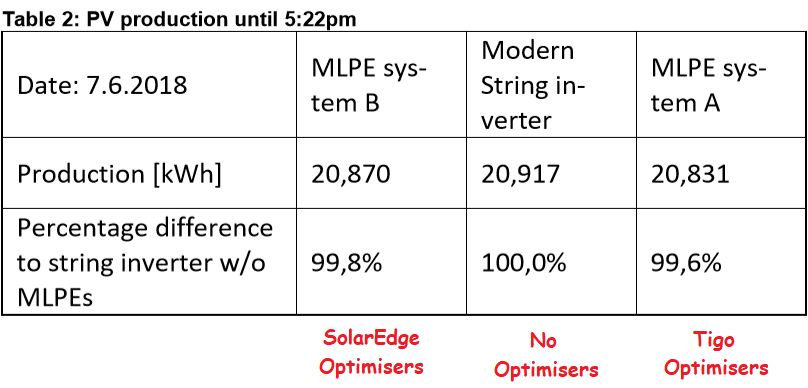

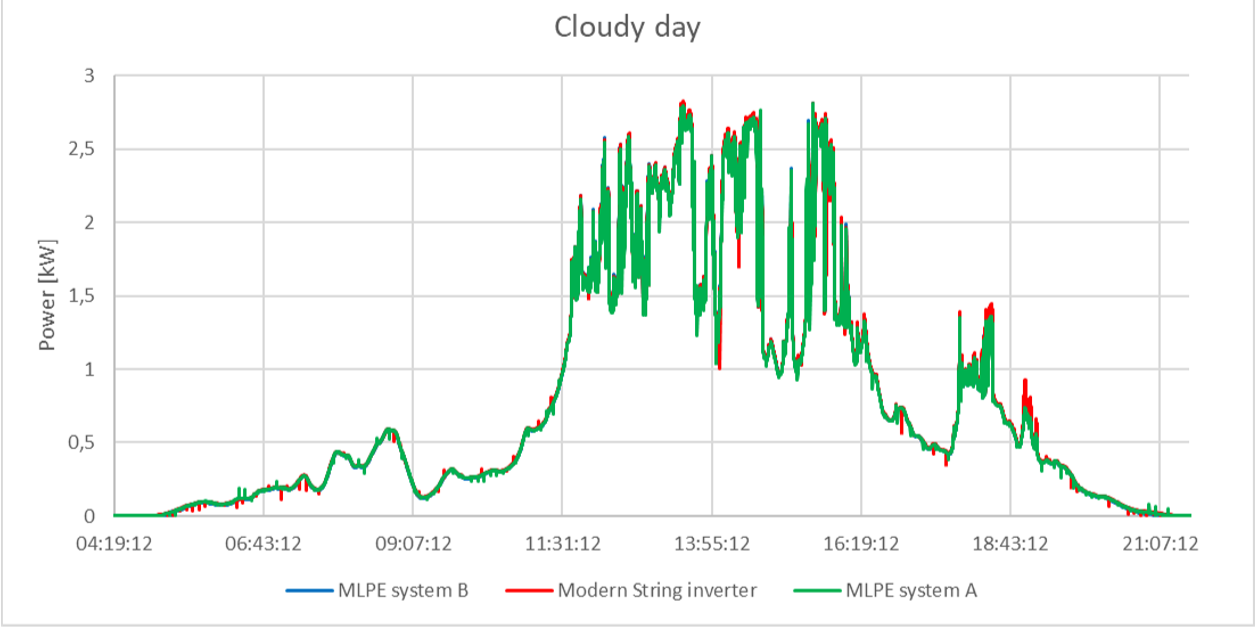
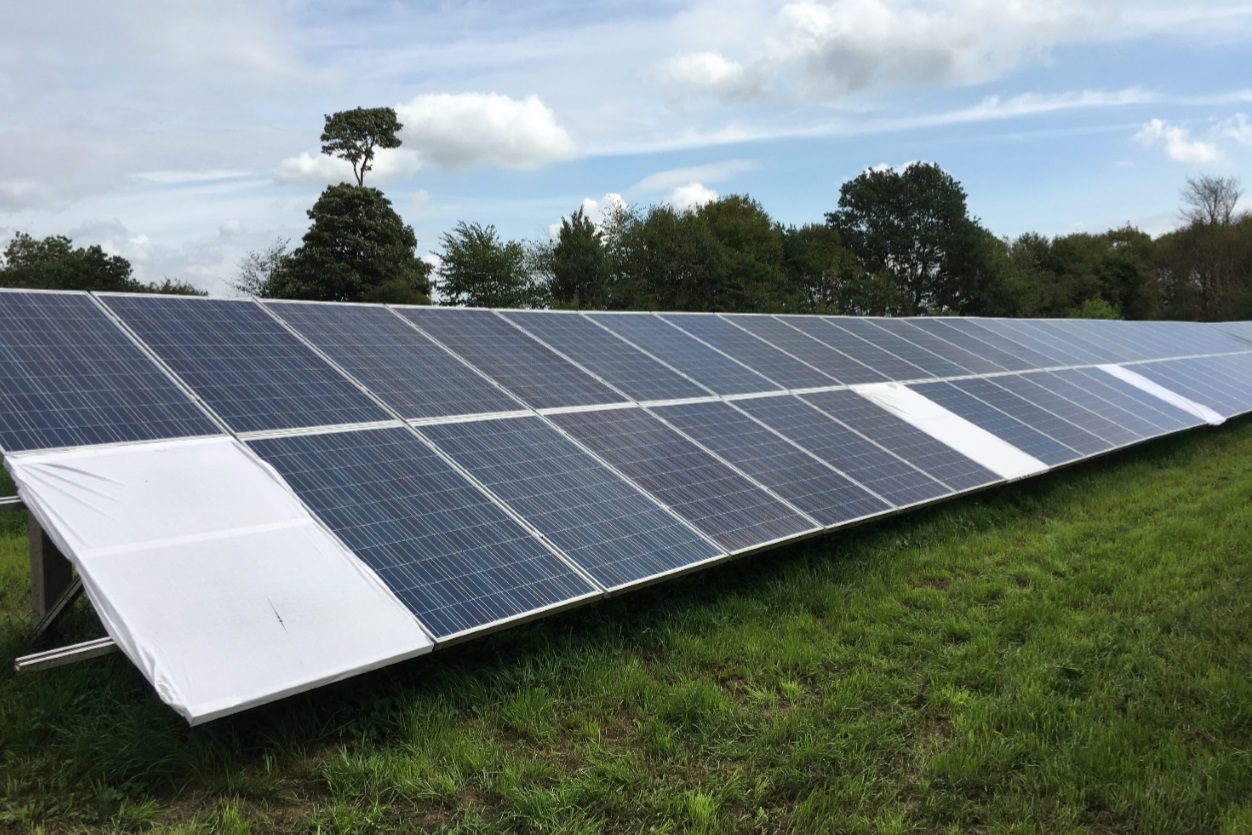
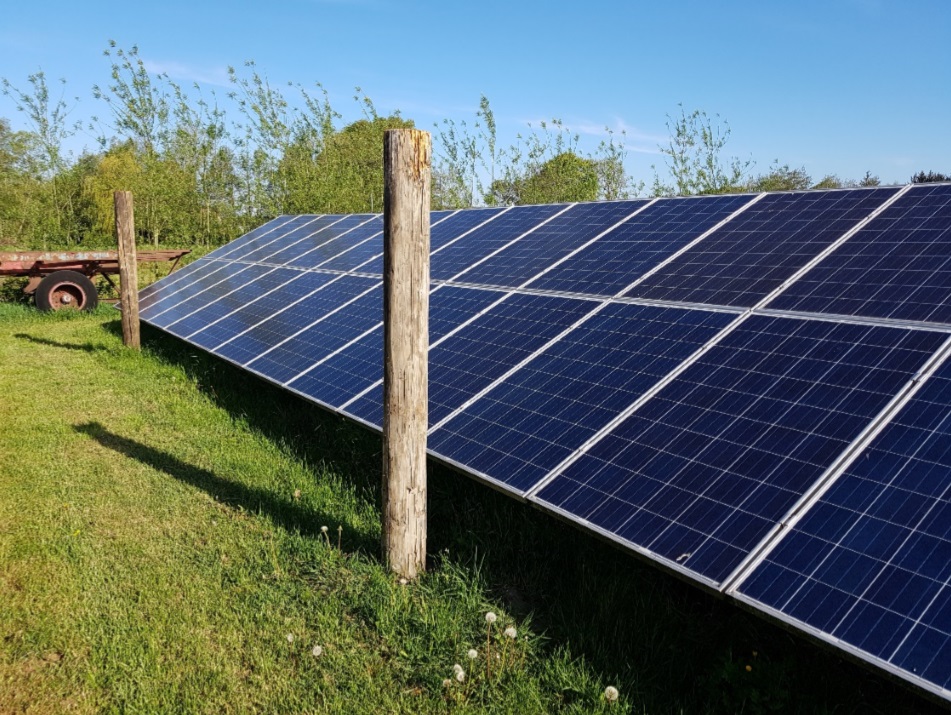
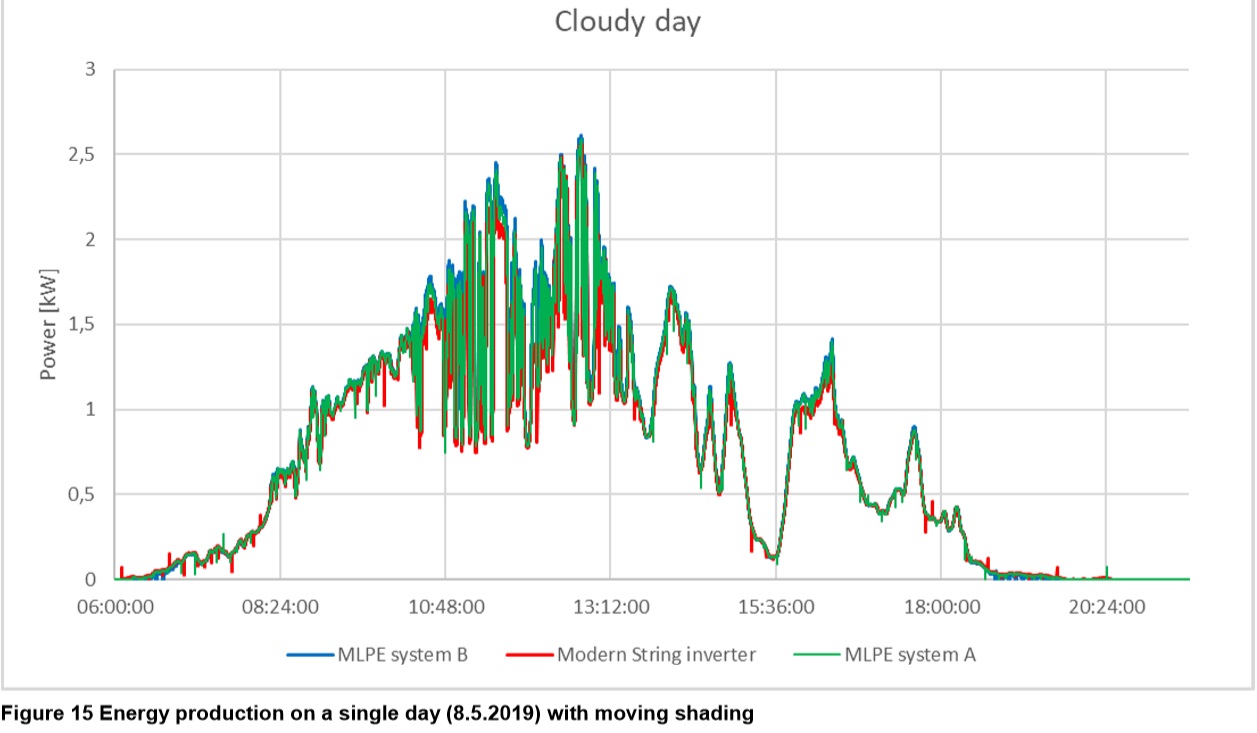
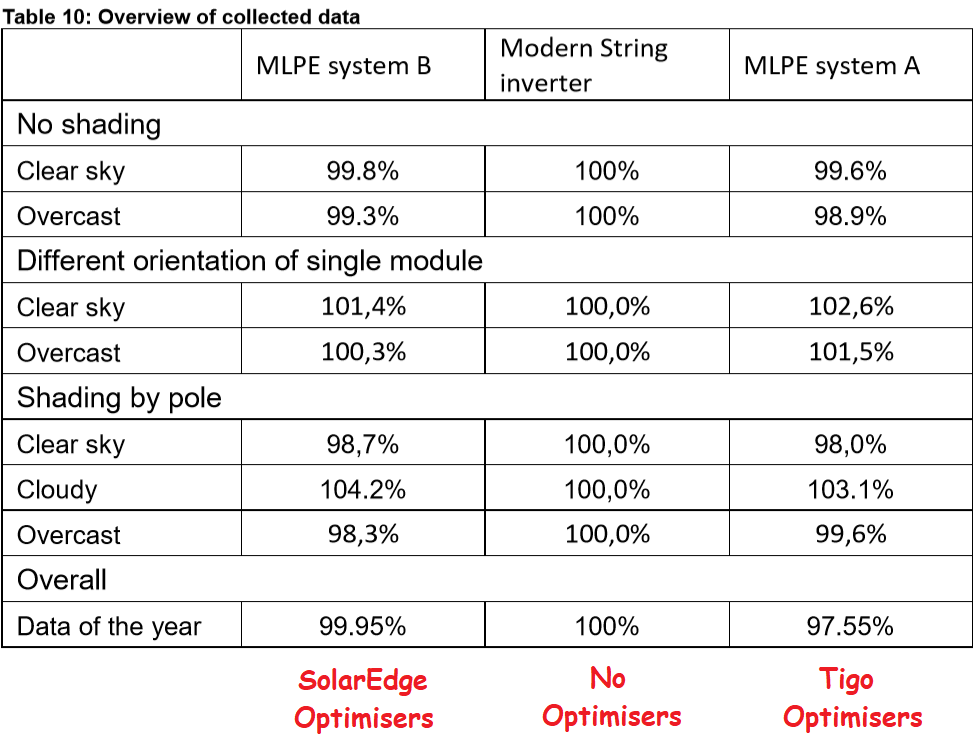



 RSS - Posts
RSS - Posts



Were all the panels flash tested at the start and end of the trial? Straight off the pallet there are some panels that under and over-perform the nameplate capacity.
A variation in output between the panels is a cause for concern, but the study said the 3 sets of panels were tested at the start and their output was found to be the same. This is not too surprising. If the panels are within specification, these days they are likely to be within 5 watts of each other and with 14 panels in each test array differences are likely to be smoothed out.
I have an eight year old system with an unshaded ground mounted array fitted with Tigo optimisers (generation 1). I believe that the benefit of optimisers is more important as the panels age. I have installed Solar Analytics in addition to the Tigo monitoring and Solar Analytics consistently warns me that my system is over producing, despite my configuration being correct.
The array consists of 42 x 250 W mono panels (96 cell) manufactured by Ningbo Ulica.
The Tigo monitoring site also shows ‘Reclaimed energy’ which is interesting to scroll through.
It is a good point that panels may not all degrade at the same rate, creating a mismatch and making optimisers more valuable.
It would be great to hear SolarEdge comment on this research. To me it sounds like a preliminary study as the methodology possibly could be tightened. In any event, it appears that to make up for the significantly extra cost of the Optimised system, the improvement over their lifetime should be much greater than -0.5% all other things being equal.
And other things are not equal. SolarEdge sell an inverted/EV charger, and in my case it’s either that or string system plus Zappi. I’ve found the cost including installation to be about the same!
One advantage of optimisers the report did not mention was that optimisers can prevent bypass diodes from activating in the first place.
For example, if a cell was receiving 20% less light than the neighboring cells, the bypass diode would normally activate. If activated regularly, that bypass diode could eventually fail, resulting in permanent loss of the substring or a damaging hotspot. Both of which could go by unnoticed because of the lack of panel-level monitoring.
Whereas an optimiser would simply reduce the current of that 1 panel by 20% and leave the bypass diode not activated.
According to Heliolytics, bypass diode failure is a common defect they see.
https://pv-magazine-usa.com/…/issues-with-bypass-diodes/
Most failed bypass diodes would probably go undetected though because most systems don’t have panel-level monitoring.
Some manufacturer warranties even exclude bypass diode failure unless optimisers or microinverters have been used – https://imgur.com/49JYXd7
Considering the stress taken off bypass diodes + panel-level monitoring, I still think MLPE is the best option for partially shaded roofs.
I concur with Ronald’s conclusion. I can’t justify a 35% increase in cost for an occasional 3% increase in output. 🙁
I would go further and say that the only entity that benefits from installing an optimised PV system is the installer!
However, I do note that, in a roof space-constrained site, an optimised system with 5kW of panels and a 5kW inverter may output closer to an oversized system comprising 6.6kW of panels and a 5kW inverter, but it’d still be more expensive and achieve questionable benefits. 🙂
I have a 12 panel solar edge system with REC panels.
When installed over 2 years ago there was little to no shading.
BUT in the meantime both neighbours have planted trees on the fenceline which now shade my North and west facing panels.
Something i would not have thought of at instal time. I wanted a “good” system so it has worked out well for me.
This could happen to any installation in suburban areas.
Hi, you have SolarEdge response here
https://www.pv-magazine.com/press-releases/solaredges-official-response-to-university-of-southern-denmark-mlpe-study/
SolarEdge reached out directly to the author of the study, and requested the raw data on which the study is based:
He refused to provide the data.
In addition, he readily admitted in his reply that, “In this case it is not the added value for the module level optimized pv systems, because the shadow is not effecting the 3 systems equally. Basically the modules with optimizers are firstly effected by the shading and therefore have less yield compared to the other optimizer system and the system without optimizers.”
This shows that the shade effect on each system that was compared was not identical.
Totally agree, I bought 13 Tigo Optimisers thinking to improve my shaded panel and it has done totally nothing that helps. The Optimiser is not cheap too, money wasted.
I have 150 panels with 75 optimizers. Right after installation, 5 optimizers failed (which the manufacturer found to be a faulty batch of PE). Why the 5 in a row? They were under the shade of an electric pole. I guess the first few days of stress killed them. That was year 0. Year 1, 2 more failed, not neighbors though. Year 2, 1 more. Year 3, another. Note that it is a 12% failure rate out of 75. Annualized to roughly 4%. Even if it is stabilizing to a lower number, it is still more than 1% failure rate per annum.
The installer was willing to give 3 year warranty because of the expectation of higher repair cost. From year 4 onward, I would have to bear the cost of replacing further failed optimizers. I have no idea to this day whether it’s worth it. But the extra cost of maintaining PE on hot roof is quite obvious by now.
Right now I am considering expanding the system by another 150 panels. I am tempted to use the same invertors/optimizers. I am also more tempted to install just string invertors alone and will be able to compare the 2.